mirror of
https://github.com/jkriege2/JKQtPlotter.git
synced 2025-01-24 06:32:12 +08:00
162 lines
7.9 KiB
Markdown
162 lines
7.9 KiB
Markdown
# Example (JKQTPlotter): Scatter Graph with Parametrized Symbols/Colors {#JKQTPlotterParamScatter}
|
|
This project (see `./examples/paramscatterplot/`) demonstrates the capabilities of `JKQTPXYParametrizedScatterGraph`. This graph class plots symbol&line-graphs, juts like [`JKQTPXYLineGraph`](https://github.com/jkriege2/JKQtPlotter/tree/master/examples/symbols_and_styles/) and in addition modifies several properties of each plot point by data from an additional column. These properties can be modified:
|
|
- symbol size
|
|
- symbol type
|
|
- symbol/line color
|
|
- line width
|
|
|
|
The source code of the main application can be found in [`paramscatterplot.cpp`](https://github.com/jkriege2/JKQtPlotter/tree/master/examples/paramscatterplot/paramscatterplot.cpp). First, several datasets are generated and added to the internal datastore. the resulting datatable looks like this:
|
|
|
|
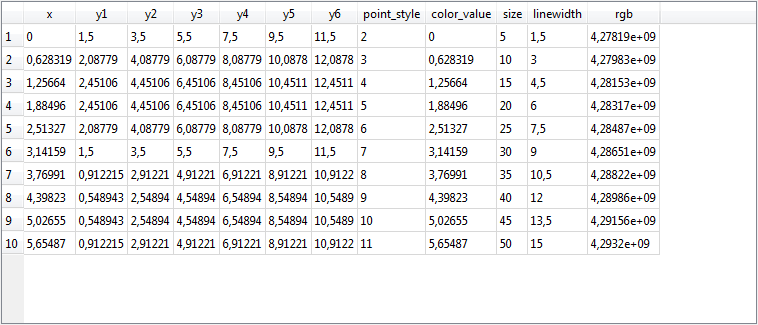
|
|
|
|
Then several plots are added that modify different properties.
|
|
|
|
The simplest case is to modify the symbol type. Simply set the property `symbolColumn` with `graph1->setSymbolColumn(columnP)` to a data column. The values in the data column will be cast to an integer and then will be translated to `JKQTPGraphSymbols`. If the numbers are larger than the available symbol types in `JKQTPGraphSymbols`, the graph will cycle through the available symbols (via a modulo-operation with the max. symbol count!).
|
|
```.cpp
|
|
JKQTPXYParametrizedScatterGraph* graph1=new JKQTPXYParametrizedScatterGraph(&plot);
|
|
graph1->setXColumn(columnX);
|
|
graph1->setYColumn(columnY1);
|
|
graph1->setSymbolColumn(columnP);
|
|
graph1->setDrawLine(true);
|
|
graph1->setColor(QColor("blueviolet"));
|
|
graph1->setTitle("1: symbol type");
|
|
plot.addGraph(graph1);
|
|
```
|
|
|
|
|
|
The next two code snippets show how to modify the size of the symbols and the line width of the lines, connecting the symbols (ensure to set `graph6->setDrawLine(true)`, because otherwise no line will be drawn). The principle is the same as above, but here you need to set the properties `sizeColumn` for the symbol size and `linewidthColumn` for the line width. All values in the line width or symbol size columns are interpreted as sizes in dtp points (pt)!
|
|
```.cpp
|
|
// symbol size
|
|
JKQTPXYParametrizedScatterGraph* graph3=new JKQTPXYParametrizedScatterGraph(&plot);
|
|
graph3->setXColumn(columnX);
|
|
graph3->setYColumn(columnY3);
|
|
graph3->setSizeColumn(columnS);
|
|
graph3->setSymbolType(JKQTPFilledCircle);
|
|
graph3->setDrawLine(true);
|
|
graph3->setTitle("3: symbol size");
|
|
plot.addGraph(graph3);
|
|
|
|
// line width
|
|
JKQTPXYParametrizedScatterGraph* graph6=new JKQTPXYParametrizedScatterGraph(&plot);
|
|
graph6->setXColumn(columnX);
|
|
graph6->setYColumn(columnY6);
|
|
graph6->setLinewidthColumn(columnLW);
|
|
graph6->setDrawLine(true);
|
|
graph6->setSymbolType(JKQTPNoSymbol);
|
|
graph6->setTitle("6: line width");
|
|
plot.addGraph(graph6);
|
|
```
|
|
|
|
|
|
Finally you can set the color of each symbol, based on data in the column `colorColumn`. Here two possibilities exist: First you can store the RGB(A) value for each datapoint explicitly. For this, you first need to create the data in the column, using the Qt-function [`qRgb()`](http://doc.qt.io/qt-5/qcolor.html#qRgb) or [`qRgba()`}(http://doc.qt.io/qt-5/qcolor.html#qRgba):
|
|
```.cpp
|
|
QVector<double> RGB;
|
|
const int Ndata=10; // number of plot points in each curve
|
|
for (int i=0; i<Ndata; i++) {
|
|
const double x=double(i)/double(Ndata)*2.0*M_PI;
|
|
RGB<<double(qRgb(double(i)/double(Ndata)*255,0,255-double(i)/double(Ndata)*255));
|
|
}
|
|
size_t columnRGB=ds->addCopiedColumn(RGB, "rgb");
|
|
```.cpp
|
|
Basically the data points in a RGB(A)-column will be interpreted by castig them to [`QRgb`](http://doc.qt.io/qt-5/qcolor.html#QRgb-typedef).
|
|
|
|
Now you can add the graph. In order to interpret the color column as RGB(A)-values, ensure to set `graph4->setColorColumnContainsRGB(true)`:
|
|
```.cpp
|
|
JKQTPXYParametrizedScatterGraph* graph4=new JKQTPXYParametrizedScatterGraph(&plot);
|
|
graph4->setXColumn(columnX);
|
|
graph4->setYColumn(columnY4);
|
|
graph4->setColorColumn(columnRGB);
|
|
graph4->setColorColumnContainsRGB(true);
|
|
graph4->setDrawLine(true);
|
|
graph4->setSymbolType(JKQTPFilledDownTriangle);
|
|
graph4->setTitle("4: RGB-color");
|
|
plot.addGraph(graph4);
|
|
```
|
|
|
|
The second variant for setting the color of each datapoint is by mapping the values in the column to a color palette (`JKQTPMathImageRYGB` in this example). For this you simply need to define the color coumn and the palette to use. By default, the color palette spans the full range of values in `colorColumn`:
|
|
```.cpp
|
|
JKQTPXYParametrizedScatterGraph* graph2=new JKQTPXYParametrizedScatterGraph(&plot);
|
|
graph2->setXColumn(columnX);
|
|
graph2->setYColumn(columnY2);
|
|
graph2->setColorColumn(columnC);
|
|
graph2->setPalette(JKQTPMathImageRYGB);
|
|
graph2->setSymbolType(JKQTPFilledRect);
|
|
graph2->setDrawLine(true);
|
|
graph2->setTitle("2: color");
|
|
graph2->getColorBarRightAxis()->setAxisLabel("color scale for graph2");
|
|
plot.addGraph(graph2);
|
|
```
|
|
Note: If you want to set the range manually, use `ste_imageMin()` and `setImageMax()` after setting `setAutoImageRange(false)`.
|
|
|
|
|
|
Note also that it is possible to combine any of parametrizations above in a single graph, by setting two or more columns:
|
|
```.cpp
|
|
JKQTPXYParametrizedScatterGraph* graph5=new JKQTPXYParametrizedScatterGraph(&plot);
|
|
graph5->setXColumn(columnX);
|
|
graph5->setYColumn(columnY5);
|
|
graph5->setColorColumn(columnC);
|
|
graph5->setSizeColumn(columnS);
|
|
graph5->setPalette(JKQTPMathImageBLUEYELLOW);
|
|
graph5->setDrawLine(true);
|
|
graph5->setTitle("5: color+size");
|
|
graph5->getColorBarRightAxis()->setAxisLabel("color scale for graph5");
|
|
plot.addGraph(graph5);
|
|
```
|
|
|
|
|
|
The full test appication combines all these variants and the result looks like this:
|
|
|
|
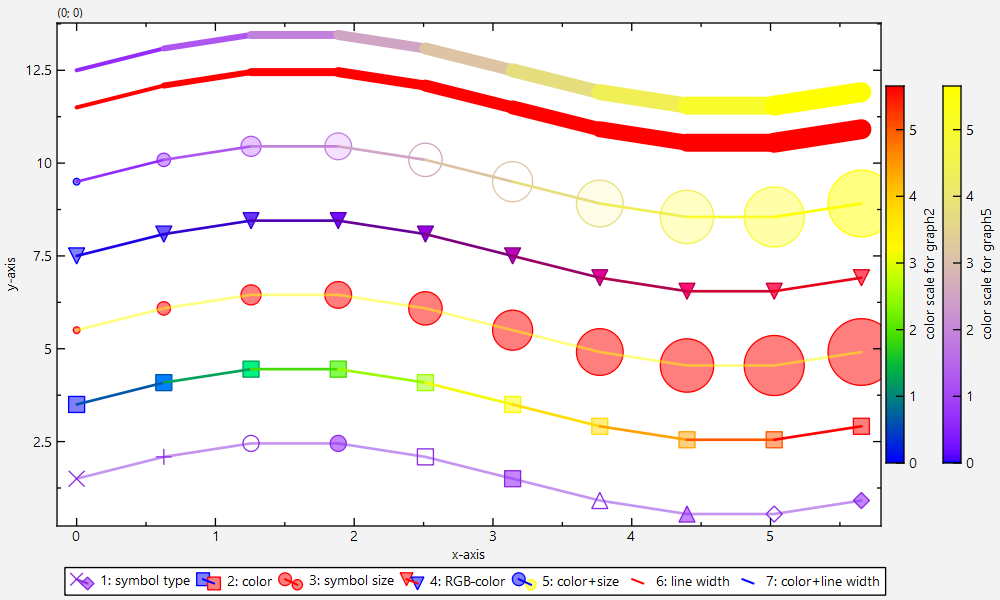
|
|
|
|
|
|
In `` you can also set special functors that transform the values from the data columns (symbol type+size, datapoint), before using them for the plot, which gives you even more control. As an example you can set a special functor to `graph6`:
|
|
|
|
```.cpp
|
|
graph6->setLinewidthColumnFunctor([](double x, double y, double w) {
|
|
return fabs(sin(w/3.0)*25.0);
|
|
});
|
|
```
|
|
|
|
This will result in modulated linewidths as shown below:
|
|
|
|
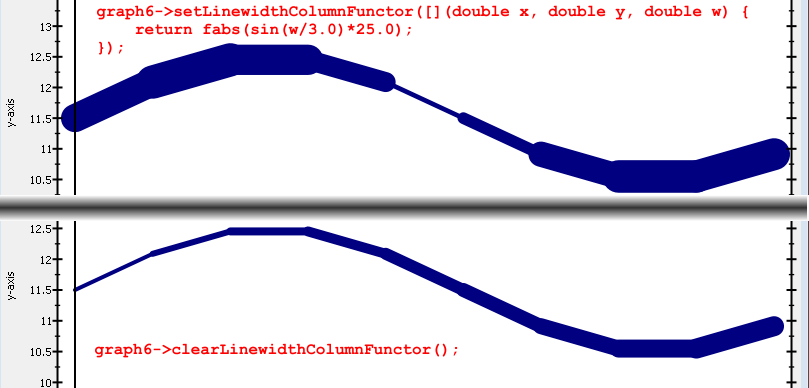
|
|
|
|
|
|
The same can be done for symbol type, e.g. with code like this:
|
|
|
|
```.cpp
|
|
graph1->setSymbolColumnFunctor([](double x, double y, double sym) -> JKQTPGraphSymbols {
|
|
if (sym<Ndata/2) {
|
|
return JKQTPGraphSymbols::JKQTPCircle;
|
|
} else if (sym>Ndata/2) {
|
|
return JKQTPGraphSymbols::JKQTPFilledCircle;
|
|
} else {
|
|
return JKQTPGraphSymbols::JKQTPPlus;
|
|
}
|
|
});
|
|
```
|
|
|
|
|
|
This will result in symbols as shown below:
|
|
|
|
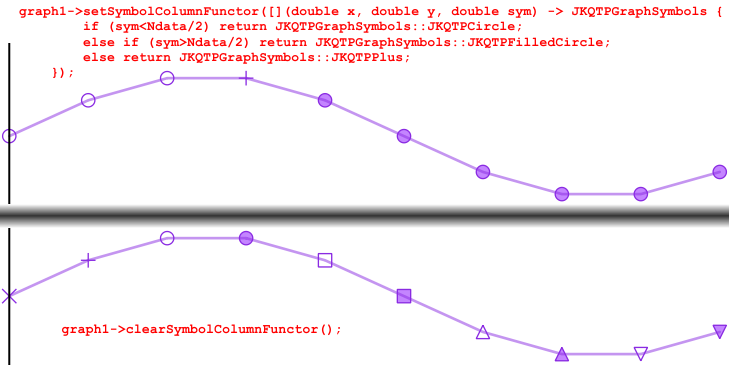
|
|
|
|
As an alternaitve for symbols, you can define the functor also in terms of a QMap:
|
|
|
|
```.cpp
|
|
graph1->setSymbolColumnFunctor([](double x, double y, double sym) -> JKQTPGraphSymbols {
|
|
if (sym<Ndata/2) {
|
|
return JKQTPGraphSymbols::JKQTPCircle;
|
|
} else if (sym>Ndata/2) {
|
|
return JKQTPGraphSymbols::JKQTPFilledCircle;
|
|
} else {
|
|
return JKQTPGraphSymbols::JKQTPPlus;
|
|
}
|
|
});
|
|
```
|
|
|
|
This will result in symbols as shown below:
|
|
|
|
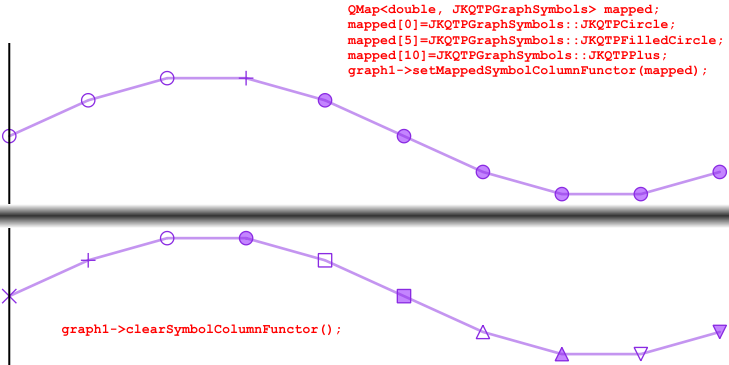
|
|
|